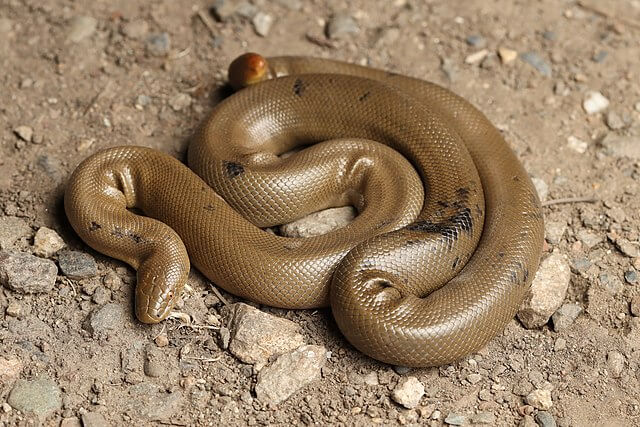Meet the Rubber Boa, Montana’s Tiny Boa Constrictor
By Michelle Cox
Broadcast 8.3 & 8.6.2022

A rubber boa resting on a rocky path. Photo by Andrew Nydam, CC 4.0.
Listen:
We chose an early start to avoid the oppressive heat and smoke we’d endured for the last month. August had arrived early in Missoula! My friend Mary and I organized our backpacks while Iris, true to her blue heeler instincts, impatiently eyed our progress from the creek. Initially, we agreed on a quick run but abandoned those ambitions for a relaxing stroll on a creekside trail. The cottonwoods and alders on the left and ponderosas and perennial grasses on the right framed the trail as if it were the subject of a painting, drawing our eyes up the valley. Mary was celebrating the variety and vigor of the riparian understory when I saw Iris sidestep a stick ahead of us. Iris leaves no stick unturned, so my curiosity was piqued. As we approached, I could see it was a rubber boa!
The boa barely reacted as I kneeled down for a closer look. Since it was fairly stretched out on the wide trail, I saw it was about 18 inches long and colored a brownish hue that blended with the soil beneath it. The scales were shiny and faintly mottled, with larger scales on the head compared to the body. It’s hard to believe these petite snakes are anacondas’ distant relatives. The most northern-ranging species of the boa constrictor family of nonvenomous snakes, their genus, Charina, means graceful, delightful. It was certainly delightful to see this secretive snake.
Maybe not the most photogenic subject, I still took dozens of photos at multiple angles. You, dear rubber boa, fascinate me! What is the key to your survival during the cool nights of western Montana?
It took all my willpower not to pick it up, but I didn’t want it to needlessly deploy one of its defense mechanisms – an unpleasant musky scent. Another defense is coiling and using their blunt tail to mimic their head. The coiled posture not only protects them, it conserves heat. Studies have found rubber boas regulate their body temperature through controlling blood flow and behavior or postures. So it makes sense that rubber boas conserve energy by avoiding quick movements.
They don’t even need quick movements or speed to hunt. Mostly active at night and the twilight hours of dawn and dusk, rubber boas ambush mice and shrews. They can slowly eat their way through a nest of young birds or mice, flicking their tails to fend off mothers trying to protect their young. I wish I had looked for the scars from those encounters.
Reluctantly, we continued on the trail in contemplative silence, leaving the boa to sun itself on the road. I read that basking on the road is a behavior more commonly displayed by pregnant females. I wondered if I had observed a female during her five-month gestation period. Would she give birth in late summer or early fall to two or maybe even eight live young? Rubber boas give birth about every four years, and I wondered how many litters she had had and how many had survived. When we returned to the spot on our way back to the car, the rubber boa had gone back into the protection of the downed trees, thick leaf litter, and rocky slopes.
I was excited to report the details of the encounter to my family. Like Iris, my blue heeler, I am usually scanning my group to ensure everyone is accounted for and safe; this distraction means I am usually not the one who finds hidden treasures like the rubber boa. Sometimes the universe places reminders at our feet to be in the moment – slow down, take notice, and wonder. Sometimes you almost trip over them.
Every week since 1991, Field Notes has inquired about Montana’s natural history. Field Notes are written by naturalists, students, and listeners about the puzzle-tree bark, eagle talons, woolly aphids, and giant puffballs of Western, Central and Southwestern Montana and aired weekly on Montana Public Radio.
Click here to read and listen to more Field Notes. Field Notes is available as a podcast! Subscribe on iTunes or wherever you listen to podcasts.
Interested in writing a Field Note? Contact Allison De Jong, Field Notes editor, at adejong [at] montananaturalist [dot] org or 406.327.0405.
Want to learn more about our programs as well as fun natural history facts and seasonal phenology? Sign up for our e-newsletter! You can also become a member and get discounts on our programs as well as free reciprocal admission to 300+ science centers in North America!












